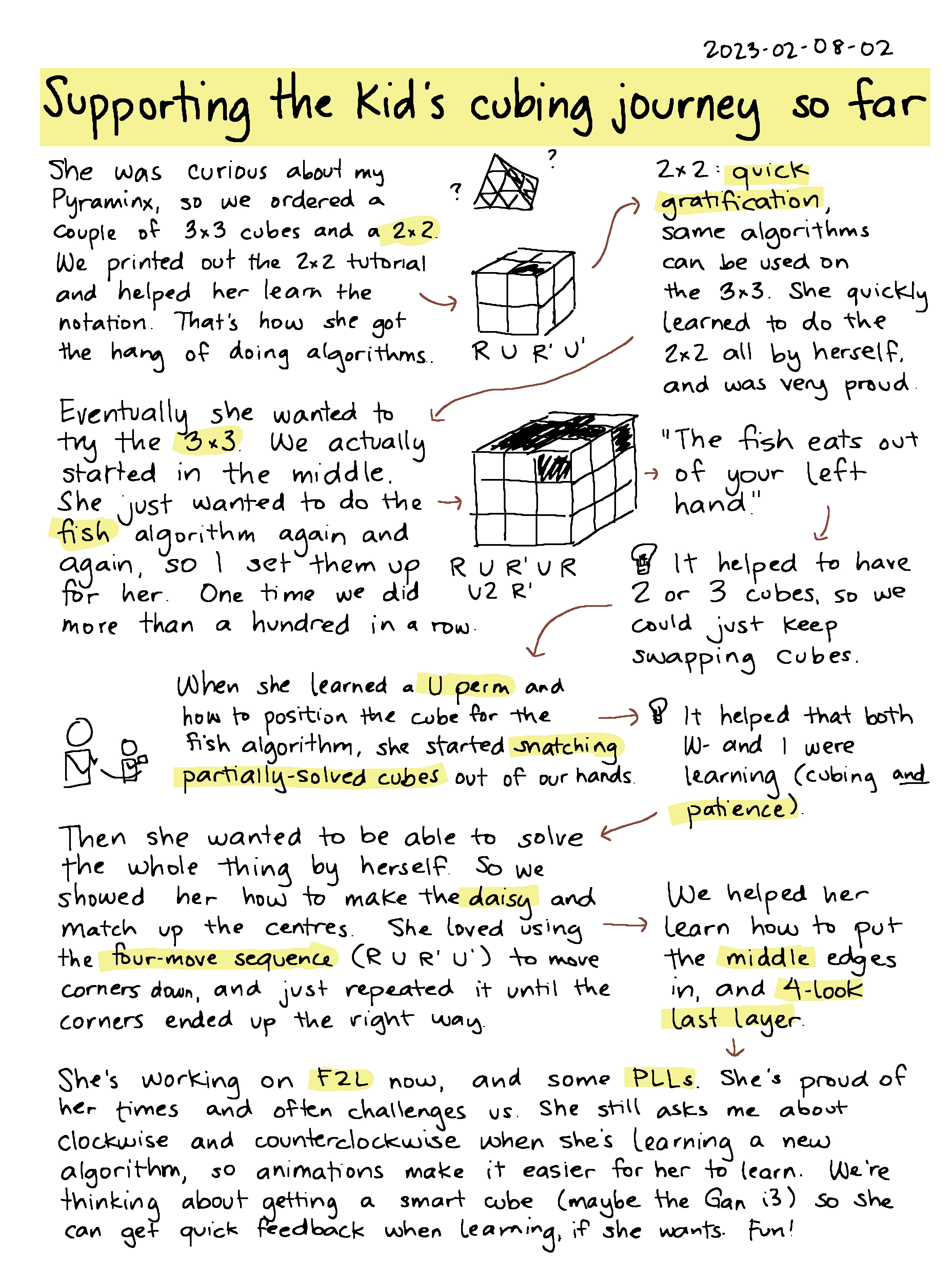Supporting A+'s cubing journey so far
| cubingWhen I was in high school, I had friends who cubed, but I didn't get into it much myself. I did keep a Pyraminx around as a reminder of those days, though. In September 2021, A+ got curious about the Pyraminx, so we decided to order a bunch of 3x3 and 2x2 cubes. We printed out the 2x2 tutorial and helped her learn the notation. The 2x2 cube skips all the middle sections, so it's a good way to practise. Here's how her learning journey has gone so far.
2x2: first layer
She learned to keep the white squares on the bottom, then line up the
next piece with a white square on top of the space she wanted it to go
down and repeat the 4-move sequence (R U R' U') until it was in the
right place and facing the right way. She learned the 4-move sequence
by doing it slowly while we showed her on a different cube, and then
she was able to practise it on her own easily, with the quick pay-off
of being able to complete a layer.
2x2: yellow squares in the second layer
The next step is to get all the yellow pieces to face up. For this, I
think we blended the 2x2 guide from the actual Rubik's company with a
print-out that showed the different ways to hold it. She liked that
because it was easy to solve by repeating just one sequence (fish: R
U R' U R U2 R' - also known as Sune). The solution guide suggested
the chant "Up, Over, Down, Over, Up, Over, Over, Down," but I think
she quickly moved to just knowing it in her fingers. (Now that I'm
looking things up for this post, I've found a nice story about a
knight and a dragon in Rubik's Cube 2x2 Storytelling Method for Kids.)
Jumping to the 3x3: fish
The fish algorithm is also very useful for solving 3x3s (and it looks more like a fish there), so around this time, she wanted me to make the fish pattern for her so that she could "solve" it. One time we did this more than a hundred times in a row. Here it really helped to have several cubes, so I could set up one cube while she solved another.
2x2: Run to me fast
Back to the 2x2. She wanted to be able to solve the whole thing herself, so she memorized the "Run to me fast" sequence from the Rubik's cube 2x2 solution guide.
- R' Run to me
- F Fast
- R' Run to me
- B2 Back back
- R Run away
- F' Fast away
- R' Run to me
- B2 Back back
That was, again, an algorithm that could easily be translated to the 3x3 cube to get the corners of the last layer all matched up.
3x3: swapping the yellow middles
The last thing A+ needed to solve the 3x3 cube starting from the fish
was to be able to swap the last unsolved pieces. She memorized the algorithm
from the Rubik's solution guide for the 3x3 (F2 U L R' F2 L' R U
F2), probably by thinking of the pattern of bringing both sides down
and up.
Then she started snatching partially-solved cubes out of our hands as soon as she recognized something she could handle. Again it helped to have several cubes on the go, and it helped that both W- and I were learning along with her. (I think I was learning more about patience than about cubing…)
3x3: working backwards from there
Eventually she wanted to be able to solve more of the cube for
herself. She learned how to put the yellow pieces into a cross, then
learned how to put the middle edges into the second layer. Somewhere
along the way, she started using the daisy method to make the white
cross on the first layer, using her old favourite R U R' U' to put
the white corners into the right places.
Going forward
She's been improving on her own. After watching videos about doing the white cross on the bottom, she stopped using the daisy and started doing the white cross on the bottom too. I think she's been working on F2L, pairing up the corner and the middle before inserting it. I've been learning some PLL algorithms, so she's been working on them too. Tucked under a blanket, we swap cubes back and forth, setting up and solving the same perms. Sometimes it's difficult for her to choose the right speed to practise something. She gets the algorithm right when she does it slowly, but mixes up a step if she tries to move quickly too soon, and then she gets frustrated. But she's learning to slow down and try again, and that's fantastic.
She doesn't usually confuse L and R, but she still asks me about
clockwise and counterclockwise sometimes. I made it easier to add
algorithm animations to the little website I keep for her on our
network. Hmm, maybe I could try some more mnemonics to help her
remember which way clockwise is using fingertricks and letter sounds:
Four balls (front right, back left)? Leave them to me (left) right
away: up right, down low (left).
It's fun to learn with her. I've been challenging myself to plan more of my crosses and pairs by closing my eyes in between sets of moves. She sometimes does the same, calling it "part-blind." She shows me fingertricks. She's faster than I am and will probably reach the 20-second PB or 30-second average before I reach the 30-second PB or 40-second average. I think there's something really interesting about having your hands learn something that your brain might still be a little slow to grasp. I'm glad this tickled her curiosity (and ours).

